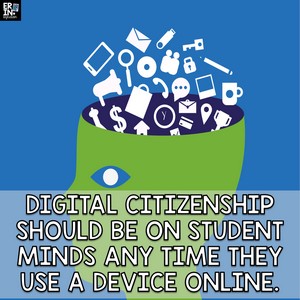Blog Following - Teaching Digital Citizenship All Year in the Classroom
This week we are looking at Erin's blog on teaching digital citizenship in the classroom. As our students gain more and more access to technology at increasingly younger ages this topic becomes more important. It is also a topic that classroom teachers can integrate into their every day classroom activities.
These are some things to consider as you revisit digital citizenship throughout the year.
#1 Acknowledge that students use technology outside of school
Plan to address real world situations with your students. Teach them how to make informed and safe choices. Teach students how to search, comment, hot to report, how to deal with ads, and how to make sure their information is reliable.
#2 Digital citizenship is not a one time lesson at the beginning of the year
While it is good to introduce the topic at the beginning of the year, you should plan to revisit and discuss all year long. Posting visuals is a good way to keep reminders around the classroom and an easy reference. One way she engages her students is to have them earn a digital license at the beginning of the year and then planning for times throughout the year when students have to renew their licenses.

Check out her blog to see how she uses her digital punch cards with her students.
#3 Consider age appropriate examples when teaching digital citizenship
You should consider the types of technologies that your students are using depending on their age level. In elementary school that might be things like Youtube, Roblox, Minecraft, or Google search. These activities would differ for middle and high school students. Your instruction should fit the group you work with.
#4 Offer concrete digital citizenship and internet safety strategies
Students need explicit instruction with regard to their online behavior, choices, and safety. Students do best when they have specific strategies to apply in tricky situations. Rather than teaching students what NOT to do, Erin suggests giving students a strategy.
#5 Give students a safe spaces to practice
Using things like Google classroom, Edmodo, Seesaw, DogoNews, Classkick, Kidblog, and other sites can be very effective in providing safe places for kids to practice things like commenting and interacting with other digital users.
#6 Practice what you preach
This simply means that teachers need to have a full understanding of the things they are asking their students to do or use.
Kayla,
ReplyDeleteI am glad you chose to share this post. I have been implementing more technology in my classroom this year and have not previously had the responsibility of discussing digital citizenship. It is an extremely important concept for students to learn and we have already run into a few issues in a couple of the fourth grade classrooms this year. The information provided in this post is very helpful! Thank you for sharing!
Natalie,
DeleteI have a digital citizenship bootcamp every year at the beginning of the year with my second graders and it's always so interesting to hear their thoughts and misconceptions. There are so many great resources out there for elementary classrooms!
Kayla,
ReplyDeleteI love the idea of a digital citizenship bootbamp with your class. So many times we just hand the students technology and tell them to have at it. Setting up procedures and teaching students how to be responsible digital citizens is very important in school and society today.